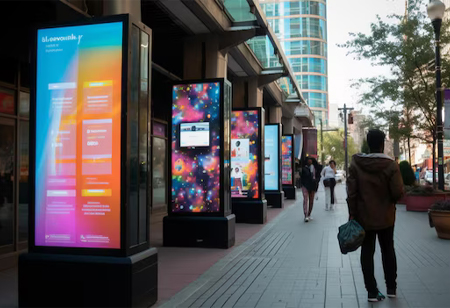India's Digital OOH Market: Transforming the Advertising Landscape
The Indian Digital Out-of-Home market has never seen this in history; technology, urbanization, and certain consumer behavior changes pushed this market forward in growth. With a forecasted CAGR of 13.8% for 2025-2030 and an estimated US$ 630 million market volume by 2030, DOOH is poised to become a major force in the Indian advertising industry.
One of the major causes for this change in the Digital OOH market is the rapid expansion of digital signage. From shopping malls to airports, metro highways, and commercial hubs have adopted digital billboards, interactive screen displays, and much more to maximize opportunities for advertisers to connect with consumers in ways previously unavailable. This trend highlights the era of smart cities where Digital OOH takes advantage of high footfall and connectivity. Junaid Shaikh, MD, RoshanSpace Brandcom, stated, “The year has kicked off with some high-profile events like Maha Kumbh and Delhi Elections. These events are expected to create substantial opportunities for OOH advertising engagement across various formats, this is well supported by the FICCI E&Y report, wherein OOH grew by 13%, higher than TV and Print, which puts the industry in a good place. By 2026, we expect DOOH to be more than 15% of the total OOH revenue.”
Additionally, Programmatic advertising is bringing all these changes into the ad space not only by entering automation as well as by real-time bidding, it has also entered data-driven targeting, which is giving advertisers great, personal ads and ad campaigns while boosting their return on investments. Vikas Nowal, CEO, of Interspace Communications, stated, “In 2025, OOH advertising spend is expected to grow by 5-7% year-over-year, building on a strong recovery post-pandemic and driven by the continued rise of Digital Out of Home (DOOH). As reported by Statista, the OOH market globally is projected to reach over $40 billion in 2025, where a large part of this growth comes from DOOH due to real-time data and precise targeting.”
Interactivity and involvement of the consumers in the DOOH arena are primarily being revolutionized by touch screens, as well as augmented realities, which engage the consumers directly. Smart screens are advancing past simple display functions, now actively responding to various environmental conditions and tailored to different audience types, ultimately creating an entirely custom experience of content delivery. It has left some other great advantages like dynamic content and real-time adjustment.
The DOOH world has established sustainability as a necessary focus because businesses and consumers become environmentally conscious. Energy-efficient digital displays will be adopted, as will eco-friendly materials and green marketing strategies. DOOH is now moving more seamlessly into mobile marketing and social media, creating a new bridge between physical and digital advertising. Technologies to connect the user with the billboard include NFC and QR codes that enable a person to move from an outdoor advertisement to an instantly connected online arena. Many brands have used the DOOH platform in their omnichannel marketing strategies by encouraging social media user engagement.
The introduction of advanced analytics is changing how advertisers assess their campaigns. They can now see immediate feedback on metrics like views, interaction rates, and viewing time, helping brands make their ads more effective and impactful. Dipankar Sanyal, CEO, of Platinum Outdoor, remarked, “We are seeing the evolution of technology in OOH. We are witnessing the integration of media in a true sense specifically on the digital front. AI-powered OOH advertising will enable highly targeted and effective OOH campaigns.”
The Indian government is taking a more accommodating approach to digital signage applications, while, with the evolution of the industry, the regulatory and legal framework is also being adopted. India's DOOH sector is transforming with programs, interaction, and sustainability. Digital becomes smart and connected for the advertiser to engage with the audience better and more creatively. With this evolving scenario, brands taking these trends forward will have a better chance to take advantage of the increasing potential of digital out-of-home advertising in India.
🍪 Do you like Cookies?
We use cookies to ensure you get the best experience on our website. Read more...






